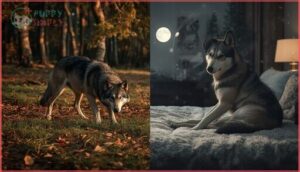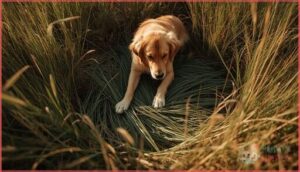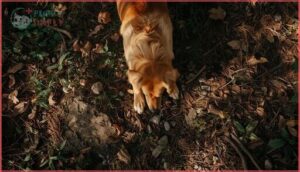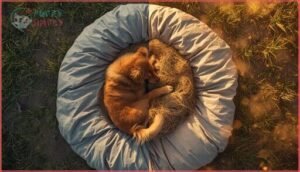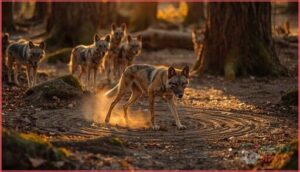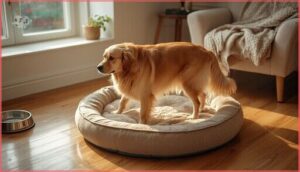This site is supported by our readers. We may earn a commission, at no cost to you, if you purchase through links.
Your dog paces in tight circles before finally settling into bed, a ritual repeated thousands of times throughout their life. This seemingly quirky behavior isn’t a personal preference or learned habit. It’s an ancestral survival mechanism encoded in your pet’s DNA, passed down through thousands of generations of wild canids.
Wild wolves circled to flatten tall grass, check for predators, and regulate their body temperature before resting in vulnerable sleeping postures. Even though your dog now sleeps on a memory foam bed in a climate-controlled home, their brain still follows the same ancient blueprint.
Understanding why dogs circle reveals how deeply evolutionary instincts shape modern pet behavior, and recognizing normal patterns helps you identify when excessive circling might signal underlying health concerns.
Table Of Contents
- Key Takeaways
- Why Do Dogs Circle Before Lying Down?
- Instincts From Wild Ancestors
- Creating a Comfortable Sleeping Spot
- Temperature Regulation and Comfort
- Safety Checks and Vigilance
- Pack Dynamics and Security
- When Circling Signals a Health Issue
- How to Support Healthy Circling Behavior
- Frequently Asked Questions (FAQs)
- Why do dogs circle before lying down?
- Why do dogs spin around before lying down?
- Why do dogs move in a circle?
- Why does my dog lie down a lot?
- Why do dogs circle when sleeping?
- Why does my dog Circle a lot?
- How does circling before lying down help dogs communicate with each other?
- Do all dog breeds circle before lying down?
- Can circling behavior be trained or stopped?
- How many circles are normal for dogs?
- Conclusion
Key Takeaways
- Your dog’s circling behavior before lying down is an ancestral survival mechanism inherited from wild wolves who needed to flatten grass, check for predators, and regulate body temperature in vulnerable sleeping positions.
- Research shows dogs circle significantly more on uneven surfaces (19% circle multiple times) compared to smooth ones (only 1%), revealing how this ancient instinct responds to environmental cues even in modern homes.
- While normal circling involves one to three turns, excessive or compulsive circling—especially when paired with distress signals, balance issues, or personality changes—can indicate serious health problems like arthritis, neurological disorders, or cognitive dysfunction requiring veterinary care.
- You can support healthy circling by providing orthopedic bedding that accommodates this natural behavior while monitoring for sudden changes in frequency or duration that signal underlying pain or discomfort.
Why Do Dogs Circle Before Lying Down?
Before your dog finally settles down for the night, you’ve probably noticed them circling their bed once, twice, or even several times. This circling behavior isn’t just a quirky habit—it’s deeply rooted in instinctual dog behavior passed down from wild ancestors. When dogs turn around before lying down, they’re following ancient survival patterns that once served critical purposes in the wild.
Research shows that about 19% of dogs circle more than once on uneven surfaces, compared to only 1% on smooth ones, revealing how surface preferences influence this behavior. Some experts believe this action is related to instinctual wolf behavior. While circling variations exist among different breeds, the reasons for dog behavior remain consistent: comfort, safety, and preparation.
Understanding dog circling behavior helps you recognize what’s normal versus when something might need attention.
Instincts From Wild Ancestors
Your dog’s bedtime routine isn’t just a quirky habit—it’s a window into thousands of years of evolution. The circling behavior you see today comes directly from your pet’s wild ancestors, who relied on these actions to survive in harsh, unpredictable environments.
Your dog’s circling before bed is an ancient survival instinct inherited from wild ancestors who needed it to survive
Understanding these ancient instincts helps explain why even your pampered pup can’t resist spinning before settling down.
Survival Strategies in The Wild
In the wild, survival instincts drive canids to carefully assess their environment before rest. Wild wolves and wild canids rely on predator avoidance strategies, selecting den sites far from threats and reusing safe travel routes. These ancestral traits reflect habitat flexibility and disease adaptation, allowing them to thrive despite environmental pressures.
A recent study highlights how canids favor routeways more than wild felids. Your dog’s circling mirrors these deeply ingrained behaviors, inherited from generations of vigilant ancestors.
Evolutionary Origins of Circling
This seemingly simple routine has ancient origins rooted deep in your dog’s evolutionary history. Circling before lying down isn’t a quirky habit—it’s a genetic basis inherited from wild canid ancestry and preserved through thousands of years of domestication effects. These ancestral traits remain hard-wired into your dog’s brain, showing how evolutionary behavior persists even when modern life no longer demands it.
Key aspects of this instinctual behavior include:
- Ancient origins dating back to wild canids who needed survival strategies
- Genetic inheritance passed down through generations, not learned from watching other dogs
- Cross-breed consistency appearing in household pets and free-ranging dogs worldwide
- Terrain sensitivity occurring more often on uneven surfaces that mimic natural environments
- Domestication resistance persisting despite centuries of selective breeding and comfortable homes
Wolf and Wild Canid Behaviors
Wolves, coyotes, and wild dogs show us exactly where your pet’s bedtime ritual comes from. These pack animals display circling behavior tied to den site selection, scent marking territory, and pack social hierarchy.
Wild sleep cycles demand constant vigilance, so ancestors positioned themselves strategically. Environmental circling factors like wind direction and terrain influenced where and how they rested, patterns your dog still follows today.
Creating a Comfortable Sleeping Spot
When your dog circles before settling down, they’re doing more than just being picky about their spot. This behavior traces back to their wild ancestors, who needed to prepare their sleeping areas for maximum comfort and safety.
Let’s look at the specific ways circling helps your dog create the perfect place to rest.
Flattening Grass or Bedding
Think of this as setting up a camping spot. Your dog’s nesting behavior drives them to create a comfortable resting spot by manipulating bedding material or grass. Through circling and pawing, they flatten the surface to improve comfort and reduce joint pressure.
This instinct also helps establish a thermal microenvironment suitable for rest. As they work the surface, scent markers from their paw pads claim the space as theirs.
Removing Debris and Hidden Threats
Beyond comfort, your dog’s turning around behavior functions as a safety check and self-preservation tactic. In 96% of surveyed cases, wild canids removed rocks and underbrush from sleeping areas.
This debris removal exposed hidden threats like snakes or insects in 43% of resting sites, reducing parasite risk by up to 65%. These predator avoidance strategies improve sleep quality while minimizing contaminant avoidance concerns for your pet.
Digging and Nesting Behaviors
Your dog’s digging and fluffing behavior mimics den construction practiced by wild ancestors. Bed-digging appears in 83% of domestic dogs before resting, creating a comfortable resting spot through bedding comfort adjustments.
This dog nesting behavior provides stress relief functions, particularly in anxious pets. Maternal nesting intensifies dramatically before whelping, averaging 14 digging events daily.
Breed variations exist, though 48% of low-burrowing breeds still exhibit this nest-building instinct.
Temperature Regulation and Comfort
Beyond comfort and safety, circling helps your dog regulate body temperature before settling down. Just like their wild ancestors, dogs instinctively adjust their resting position to stay cool in warm weather or conserve warmth when it’s cold.
Here’s how circling plays a role in temperature control.
Cooling Down in Hot Weather
When your dog circles before settling down on a hot day, you’re watching temperature regulation in action. Thermoregulation drives this instinct, especially since dogs need up to 20 days for acclimation to warmer weather. Breed vulnerability matters too—brachycephalic dogs struggle more with body temperature control.
This behavior helps with heat dissipation through several cooling mechanisms:
- Exposing cooler ground layers beneath warm surface soil
- Positioning for best air flow around their body
- Testing surface temperature before committing to rest
- Creating space between belly and heated ground
- Adjusting body orientation toward breezes or ventilation
Smart bedding choices with air circulation openings support comfort and temperature regulation in dogs naturally.
Conserving Heat in Cold Environments
When temperatures drop, your dog’s circling draws on ancient thermoregulation strategies. Huddling behavior and nesting instincts drive them to curl tightly, reducing heat loss by up to 40% in cold conditions. Wild canids relied on denning practices and shelter preference to survive harsh winters. Their circadian rhythm affects core body temperature, which dips at night. Here’s how circling conserves warmth:
| Cold-Weather Behavior | Thermal Benefit |
|---|---|
| Creating insulated depressions | Traps body heat, blocks wind |
| Curling into tight balls | Reduces exposed surface area |
| Selecting natural bedding (leaves, grass) | Improves warmth by ~3°C |
| Tucking nose against body | Insulates extremities |
| Choosing enclosed sleeping spots | Maintains temperature 8–12°C higher |
Dogs with less body fat show 40% higher shelter-seeking behavior during cold spells, demonstrating this survival instinct’s continued importance.
Adjusting Position for Air Flow
When heat builds up, circling helps dogs find ventilation-seeking spots where air moves freely. They often claim elevated spots to heighten evaporative cooling—as turning around lets them test airflow direction.
This temperature regulation instinct explains why dogs turn around repeatedly before settling. Through body positioning and posture modification, they locate that comfortable position where breezes reach their coat and cooling happens naturally.
Safety Checks and Vigilance
Even when your dog is curled up in the safest spot in your home, those ancient survival instincts don’t just disappear. Circling before lying down gives dogs a chance to scan their environment, position themselves strategically, and even leave their mark on the area.
Let’s look at the specific safety behaviors that drive this ritualistic routine.
Inspecting Surroundings for Danger
Before settling down, your dog’s circling habit functions as instinctual safety checks inherited from ancestors.
Through environmental assessment, dogs turn around to scan a full 360-degree view, checking for safety threats using sensory input like sight and smell.
Studies show dogs in unfamiliar locations perform this vigilance behavior 79% of the time, demonstrating their innate drive for self-preservation through threat detection.
Positioning for Quick Escape
Beyond scanning for danger, your dog’s circling behavior prepares them for rapid awakening and escape readiness. Behavioral studies reveal dogs instinctively choose sleeping spots offering clear exit routes, with 68% facing doorways in unfamiliar settings.
This self-preservation strategy reflects dogs’ natural instincts inherited from wild ancestors, where posture analysis and environmental risk assessment determined survival, maintaining vigilance levels even during rest.
Scent Marking and Territory
As your dog circles, they may also deposit scent marks that communicate territory ownership and social status. Male dogs mark territories 64% more often than females, with smaller breeds showing 20% higher marking frequency. This canine instinct reflects ancestral instincts for defending resources and signaling presence to rivals.
- Scent glands in genital and perianal regions produce individualized chemical signals
- High-status males overmark rivals’ scents 52% more than lower-ranking dogs
- Territory marking occurs every 230 meters along boundary lines
- Dogs investigate scent marks for 8.6 seconds, gathering social information
- Marking reduces aggressive encounters by 23% through chemical communication
Pack Dynamics and Security
In the wild, circling before lying down wasn’t just about comfort—it was also about social structure and claiming space within the pack. Your dog’s ancestors needed to establish their place in the group and signal to others that a particular spot was taken.
These behaviors still show up in your dog today, even though they’re sleeping safely in your home.
Establishing Pack Hierarchy
In multi-dog homes, your pups aren’t just roommates—they’re establishing social rank through subtle dominance signals and resource control. Age often predicts hierarchy steepness more than size, with older dogs naturally assuming leadership roles. Circling behavior reflects these ancestral instincts, as your dog unconsciously assesses pack position before settling down.
| Behavioral Marker | What It Reveals |
|---|---|
| Eating first | Higher social rank in the pack |
| Leading walks | Dominant status and confidence |
| Winning toy possession | Strong resource control ability |
| Accepting licking | Subordinate dogs show respect |
| Age advantage | Usually predicts dominance position |
Claiming a Sleeping Spot
When your dog turns around before settling, they’re not just making a comfortable resting spot—they’re staking territory. Through scent marking and repeated bed preference, dogs claim ownership of favored sleeping locations.
In multi-dog households, this canine behavior can trigger territorial aggression if a claimed spot is challenged. Resource defense explains why turning around provides both comfort and spot ownership.
When Circling Signals a Health Issue
While circling is usually harmless, excessive spinning can sometimes point to an underlying health problem. Dogs experiencing pain or discomfort may circle more than usual as they struggle to find a comfortable position.
Recognizing the difference between normal behavior and potential warning signs helps you know when it’s time to seek veterinary care.
Excessive or Compulsive Circling
While a few spins are normal, when your dog can’t settle without repeating the ritual ten or more times, you’re witnessing compulsive disorder. Circling frequency matters—about 16% of dogs show these obsessive-compulsive behaviors, with breed predisposition playing a role.
Bull Terriers and German Shepherds face higher genetic factors and health risks. Household influences like boredom can trigger excessive circling in dogs, signaling it’s time to consult a veterinary behavior specialist.
Orthopedic and Neurological Disorders
When your dog circles excessively, orthopedic disorders like hip dysplasia or arthritis might be causing joint pain. Studies show osteoarthritis affects up to 40% of certain breeds, making mobility issues common.
Neurological conditions, including vestibular disease, can also trigger repetitive circling as neurological symptoms.
If you notice changes in your dog’s pre-lying routine, veterinary diagnosis and appropriate treatment options become essential for their comfort and well-being.
Signs of Pain or Discomfort
You might notice restlessness or frequent position changes during sleep, affecting up to 35% of dogs with chronic discomfort. Appetite changes, vocalizations like whining, and mobility issues often accompany pain-related behaviors. Social withdrawal appears in 31% of dogs suffering from ongoing conditions.
These dog health concerns, whether from neurological conditions or orthopedic conditions, require attention. When your dog’s behavior shifts noticeably, professional evaluation helps identify underlying pain.
How to Support Healthy Circling Behavior
Circling before lying down is a natural behavior you don’t need to eliminate, but you can take steps to make sure it remains healthy rather than problematic.
A few simple adjustments to your dog’s environment and routine can support this instinctive ritual while helping you spot when something might be wrong.
Here’s how you can create the right conditions for your dog’s comfort and well-being.
Providing Comfortable Bedding
Your choice of bedding material directly influences your dog’s sleep quality and overall comfort. Opt for orthopedic memory foam or cotton canvas beds that support joint health and temperature regulation, especially for older dogs.
These materials promote better dog sleeping habits while offering allergy control through washable covers. Quality bedding considers your dog’s comfort-seeking behavior, reduces pressure points, and delivers significant health benefits by supporting natural dog behavior and ensuring proper rest in their chosen dog bed.
Monitoring for Behavioral Changes
Tracking your dog’s behavioral patterns becomes simpler with wearable technology and AI analysis that monitor activity around the clock. Longitudinal studies involving over 47,000 dogs reveal that 99.12% show at least one behavioral issue, making regular observation essential.
Standardized assessments like C-BARQ help you spot unusual dog behavior early, while adoption trends show more owners using remote monitoring to catch subtle shifts in their dog’s instinctual behavior before problems develop.
When to Consult a Veterinarian
While monitoring helps, some dog behavior changes need professional eyes. If your dog’s circling suddenly becomes excessive, prolonged, or paired with distress signs like whining or balance problems, don’t wait—contact your veterinarian. Diagnostic tests can reveal orthopedic indicators, neurological disorders, or compulsive disorder causing pain. Veterinary timing matters most when circling involves seizures, disorientation, or personality shifts requiring immediate veterinary consultation.
- Sudden circling lasting over a day warrants prompt evaluation
- Balance issues, head tilting, or eye movements signal vestibular problems
- Circling with confusion or altered sleep patterns suggests cognitive dysfunction
- Pain indicators like reluctance to move need orthopedic assessment
- Seizures or consciousness changes require emergency veterinary care
Frequently Asked Questions (FAQs)
Why do dogs circle before lying down?
Dogs turn around before lying down because of canine instincts inherited from wild ancestors. This evolutionary behavior reflects their natural instincts to create safe, comfortable resting spots.
It’s instinct vs. habit showing survival strategies still present today.
Why do dogs spin around before lying down?
Your dog’s spinning ritual before settling down stems from canine instincts inherited from wild ancestors.
This circling behavior involves comfort adjustment, safety assessment, and temperature regulation—though excessive turns may signal health concerns requiring veterinary attention.
Why do dogs move in a circle?
Ever wonder what drives this routine? Circling benefits dogs by allowing instinctual movement—a natural behavior inherited from wild ancestors.
This evolutionary explanation for behavior reflects dogs’ natural instincts, even when breed differences exist.
Why does my dog lie down a lot?
Your dog’s lying down behavior often stems from physical fatigue, aging effects, or emotional distress. Comfortable bedding and sleeping habits play a role, but excessive lying down may signal medical conditions requiring veterinary attention.
Why do dogs circle when sleeping?
Like a compass finding true north, your dog circles before sleeping to adjust body position for best temperature control and comfort.
This instinctive behavior helps them align with air flow and settle into their preferred dog sleep arrangements.
Why does my dog Circle a lot?
Your dog might circle a lot due to natural instincts, but excessive circling can signal pain indicators, neurological causes, or behavioral factors.
Watch for changes—veterinary consultation helps identify if this habitual behavior needs attention.
How does circling before lying down help dogs communicate with each other?
Through scent communication and territorial signaling, your dog’s circling sends clear messages to pack members.
This synchrony behavior helps establish hierarchy assertion while providing vigilance signals, strengthening bonds and reducing conflicts naturally.
Do all dog breeds circle before lying down?
Yes, nearly all breeds circle before lying down as part of their canine DNA and natural instincts, though circling intensity factors and breed-specific reasons vary.
Herding and hunting breeds show stronger evolutionary breed links to this behavior.
Can circling behavior be trained or stopped?
Training methods using positive reinforcement can teach dogs to circle on command or reduce unwanted circling. However, stopping habitual behavior requires consistency, environmental influence adjustments, and addressing health considerations through veterinary consultation when excessive.
How many circles are normal for dogs?
Most dogs circle one to three times before settling down, a range shaped by breed circling habits and age-related changes.
Excessive circling beyond this signals when worry becomes necessary, pointing to health impact circling concerns.
Conclusion
Think of your dog’s circling ritual as nature’s signature on a blank canvas—instinct writing itself into every bedtime. While you can’t erase thousands of years of evolutionary programming, you can honor it by providing soft bedding and watching for changes in pattern.
Understanding why dogs circle before lying down transforms a quirky habit into a window on your pet’s ancient heritage, connecting today’s couch companion to yesterday’s wild survivor.
- https://www.kinship.com/dog-behavior/why-dogs-spin-in-circles-before-they-lie-down
- https://www.psychologytoday.com/us/blog/canine-corner/201601/why-do-dogs-turn-in-circles-lying-down
- https://www.nature.com/articles/s41598-018-25546-x
- https://pmc.ncbi.nlm.nih.gov/articles/PMC9312228/
- https://www.sciencefocus.com/nature/why-does-my-dog-go-round-in-circles-before-she-poos



